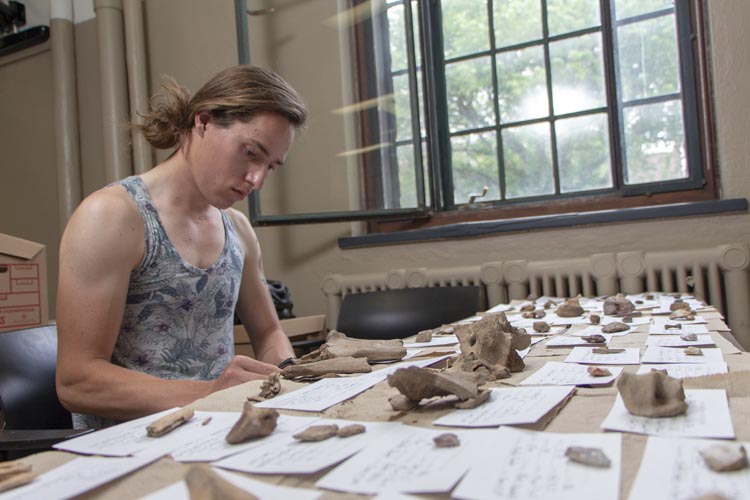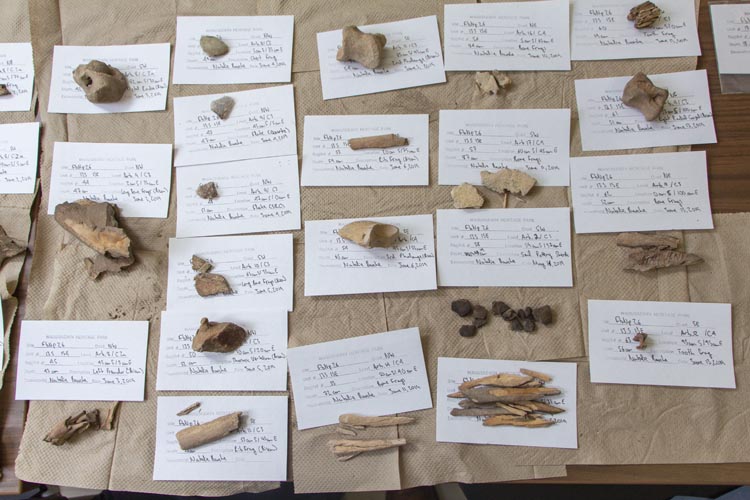
‘An adrenaline rush’—USask students find rare dart tip and other treasures at archaeology field school
On the last day of a six-week dig at Wanuskewin Heritage Park, Kristina Chomyshen found something special
By Chris Putnam
It was the perfect ending to Kristina Chomyshen’s first archaeological dig.
On June 17, the last day of a six-week field school at Wanuskewin Heritage Park, the undergraduate archaeology student in the University of Saskatchewan’s College of Arts and Science dug up something special.
“All of the sudden I find this beautiful point that’s complete. Normally when we find them they’re broken and fragmented. That one was beautifully complete,” said Chomyshen.
Chomyshen had uncovered a 6,000-year-old Gowen point, the stone tip of a dart used by a member of an ancient Indigenous hunter-gatherer group.
It is the oldest artifact ever found at the Wolf Willow archaeological dig site, and among the oldest discoveries in the entire park.
“It was really awesome when I found that—a bit of an adrenaline rush,” said Chomyshen, who is originally from Bladworth, Sask.

Chomyshen’s professors, Dr. Glenn Stuart (PhD) and Dr. Ernest Walker (PhD), were also excited by the find.
“It’s really exquisite. It’s like finding somebody’s identification card. You know everything about them. All I need to see is the shape of the projectile point, how it was made, what it was made out of, and it gives you all that information—so it’s wonderful,” said Walker, a distinguished professor of archaeology and anthropology who has led excavations at Wanuskewin for decades.
The dart tip is made from a piece of chert whose source was likely somewhere far from the park, Walker said.

Undergraduate students of archaeology in the College of Arts and Science visit Wanuskewin each spring for what is usually their first taste of a real archaeological dig. The park north of Saskatoon is the home of Canada’s longest-running archaeological research project.
Students uncover thousands of artifacts each season—tools, stone shards, pottery, animal bones and more—including occasional rare discoveries concerning the Indigenous Peoples who used the area as a gathering place for millennia.
The annual field school is about more than research, Walker said. Tourists from around the world visit Wanuskewin and the dig site, where it falls to the students to communicate about the work underway.
“They have to actually do the tours and engage the public, engage the schoolkids, tell them what they’re doing and talk about their science,” said Walker. “That freaks them out a little bit at the beginning, but they certainly get into it.”
The findings at Wanuskewin sometimes appear mundane to visitors whose idea of archaeology comes from the Indiana Jones films, Walker said, but even small fragments are important.
“It’s not so much the object itself, it’s what you can do with that object—the story that it will tell.… We find all these little bits and pieces and we have a lot of different tools and procedures that we can follow to tell a much larger, more robust story—and that’s the nature of archaeology.”

Chomyshen said she is happy to get experience at a dig site close to home before venturing further out into the field.
“It’s been a lot of fun,” she said. “It’s such a good group to work with and a very good learning experience.”
Chomyshen, who pursued a women’s and gender studies degree before returning to the College of Arts and Science to study archaeology, hopes to eventually enrol in a master’s program in osteology—the study of bones.
She said she enjoyed the opportunity to learn more about bones under knowledgeable teachers such as Walker and Stuart, and to explore her other interest in taphonomy—the study of how organisms decay and are preserved after death.
“I know I have a love for taphonomy and osteology, so I really want to find a way to do some research combining the two,” Chomyshen added.

Chomyshen’s class will be the last to participate in a dig at the Wolf Willow site. After nine years of excavations, the site will be retired in July.
Next year’s archaeological field school will likely move to another location within Wanuskewin, said Walker, but no decisions have been made yet.
Archaeological work by students is an important part of the park’s history, noted Walker. The distinguished professor is involved in writing a proposal seeking UNESCO World Heritage status for Wanuskewin.
“Our submission … is largely based on archaeology. So you might say it’s largely based on the work that students have done in field schools all these years,” Walker said.

